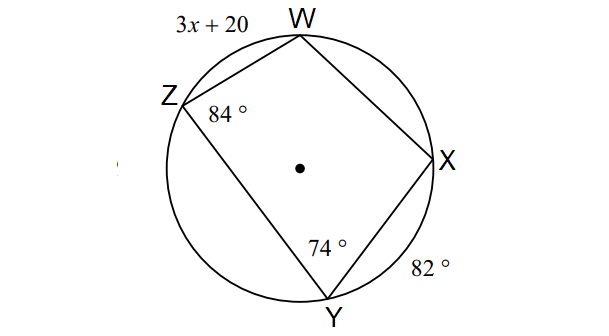INSCRIBED QUADRILATERALS WORKSHEET
Subscribe to our ▶️ YouTube channel 🔴 for the latest videos, updates, and tips.
Problem 1 :
In the diagram shown below, find the following measures :
m∠A, m∠B and m∠C

Problem 2 :
In the diagram shown below, find the following measures :
m∠P and m∠R

Problem 3 :
In the diagram shown below, find the value of x.

Problem 4 :
In the diagram shown below, find the value of x.

Problem 5 :
In the diagram shown below, find the value of x.

Problem 6 :
In the diagram shown below, find the value of x.

Problem 7 :
In the diagram shown below, find the values of x and y.


Answers
1. Answer :

In the above diagram, quadrilateral ABCD is inscribed in a circle. Then, its opposite angles are supplementary.
m∠A + m∠C = 180° ----(1)
m∠B + m∠D = 180° ----(2)
In (2), substitute m∠D = 87°.
m∠B + 87° = 180°
Subtract 87° from both sides.
m∠B = 93°
In the circle above,
m∠arc BC + m∠arc CD + m∠arc BAD = 360°
112° + 118° + m∠arc BAD = 360°
230° + m∠arc BAD = 360°
Subtract 230° from each side.
m∠arc BAD = 130°
By Inscribed Angle Theorem,
m∠C = 1/2 ⋅ m∠arc BAD
m∠C = 1/2 ⋅ 130°
m∠C = 65°
In (1), substitute m∠C = 65°.
m∠A + 65° = 180°
Subtract 65° from both sides.
m∠A = 115°
2. Answer :

In the circle above,
m∠arc PQ + m∠arc PS + m∠arc QRS = 360°
92° + 64° + m∠arc QRS = 360°
156° + m∠arc QRS = 360°
Subtract 156° from both sides.
m∠arc QRS = 204°
By Inscribed Angle Theorem,
m∠P = 1/2 ⋅ m∠arc QRS
m∠P = 1/2 ⋅ 204°
m∠P = 102°
In the above diagram, quadrilateral PQRS is inscribed in a circle. Then, its opposite angles are supplementary.
m∠P + m∠R = 180°
Substitute m∠P = 102°.
102° + m∠R = 180°
Subtract 102° from both sides.
m∠R = 78°
3. Answer :

In the diagram above, by Inscribed Angle Theorem,
m∠arc WXY = 2m∠Z
Substitute m∠Z = 84°.
m∠arc WXY = 2(84°)
m∠arc WXY = 168°
m∠arc WX + m∠arc XY = 168°
Substitute m∠arc XY = 82°.
m∠arc WX + 82° = 168°
Subtract 82° from both sides.
m∠arc WX = 86°
Again, by Inscribed Angle Theorem,
m∠arc ZWX = 2m∠Y
m∠arc ZW + m∠arc WX = 2m∠Y
Substitute.
3x + 20 + 86 = 2(74)
3x + 106 = 148
Subtract 106 from both sides.
3x = 42
Divide both sides by 3.
x = 14
4. Answer :

In the diagram above, by Inscribed Angle Theorem,
m∠arc MLK = 2m∠J
Substitute m∠J = 80°.
m∠arc MLK = 2(80°)
m∠arc MLK = 160°
In the circle above,
m∠arc MJ + m∠arc JK + m∠arc MLK = 360°
Substitute.
23x + 5 + 126 + 160 = 360
23x + 291 = 360
Subtract 291 from both sides.
23x = 69
Divide both sides by 23.
x = 3
5. Answer :

In the diagram above, by Inscribed Angle Theorem,
m∠C = 1/2 ⋅ m∠arc BAD
m∠C = 1/2 ⋅ (m∠arc BA + m∠arc AD)
Substitute.
56x + 1 = 1/2 ⋅ (62 + 164)
56x + 1 = 1/2 ⋅ (226)
56x + 1 = 113
Subtract 1 from both sides.
56x = 112
Divide both sides by 56.
x = 2
6. Answer :

In the diagram above, by Inscribed Angle Theorem,
m∠arc URS = 2∠T
m∠arc UR + m∠arc RS = 2∠T
Substitute.
m∠arc UR + 114° = 2(97°)
m∠arc UR + 114° = 194°
Subtract 114° from both sides.
m∠arc UR = 80°
Again, by Inscribed Angle Theorem,
m∠S = 1/2 ⋅ m∠arc RUT
m∠S = 1/2 ⋅ (m∠arc UR + m∠arc UT)
Substitute.
m∠S = 1/2 ⋅ (80° + 104°)
m∠S = 1/2 ⋅ 184°
m∠S = 92°
In the above diagram, quadrilateral PQRS is inscribed in a circle. Then, its opposite angles are supplementary.
m∠U + m∠S = 180°
Substitute.
8x + 8 + 92 = 180
8x + 100 = 180
Subtract 100 from both sides.
8x = 80
Divide both sides by 8.
x = 10
7. Answer :

In the above diagram, quadrilateral ABCD is inscribed in a circle. Then, its opposite angles are supplementary.
|
m∠A + m∠C = 180° 7y - 2 + 25x - 2 = 180 25x + 7y - 4 = 180 25x + 7y = 184 ----(1) |
m∠B + m∠D = 180° 7y + 1 + 22x + 7 = 180 22x + 7y + 8 = 180 22x + 7y = 172 ----(2) |
(1) - (2) :
3x = 12
Divide both sides by 3.
x = 4
Substitute x = 4 in (1).
25(4) + 7y = 184
100 + 7y = 184
7y = 84
y = 12
Therefore,
x = 4 and y = 12
Subscribe to our ▶️ YouTube channel 🔴 for the latest videos, updates, and tips.
Kindly mail your feedback to v4formath@gmail.com
We always appreciate your feedback.
About Us | Contact Us | Privacy Policy
©All rights reserved. onlinemath4all.com
Recent Articles
-
Specifying Units of Measure
Dec 15, 25 07:09 PM
Specifying Units of Measure -
Quantitative Reasoning Questions and Answers
Dec 14, 25 06:42 AM
Quantitative Reasoning Questions and Answers -
Coin Tossing Probability
Dec 13, 25 10:11 AM
Coin Tossing Probability - Concept - Sample Space - Formula - Solved Problems